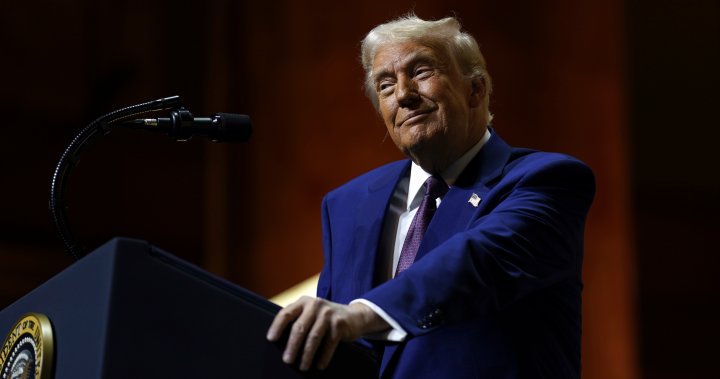If U.S. President Donald Trump imposes tariffs on Canadian goods as he’s repeatedly threated to do, experts say Canada has a strong case to challenge it under the Canada-U.S.-Mexico free trade agreement.
The question, though, is how quickly any decision may come through the process — and more importantly, whether the U.S. would respect any decisions from the outcome.
“A rules-based system is only as good as the willingness of the government who’s subject to it, to comply with it,” said Wendy Wagner, a partner at Gowling WLG.
The free trade agreement is a nation-to-nation agreement, so there’s no one else to appeal to if a country decides not to respect a decision.
America’s past performance on adhering to trade decisions has been mixed. Areas of contention include complicated measures such as figuring out how much foreign content is in an automobile or the long-running softwood lumber dispute.
What Trump has threatened, though — blanket 25 per cent tariffs on Canadian goods, with the exception of 10 per cent tariffs on energy — doesn’t contain much grey area, said Wendy.
“We’re not arguing around the edges here,” she said.
“There couldn’t be anything more offensive to a free trade agreement than a 25 per cent across-the-board tariff on all the products that originate from that country. It’s the most blatantly antithetical measure that you could impose.”

The blatancy of the threatened measures do bring into question whether any ruling through treaty channels will have much impact, Wagner said.
“There’s a larger issue about the extent of adherence to a rules-based system, both internationally and domestically.”
The U.S. has already shown a disregard to findings in the past. When it imposed metal tariffs in 2018 the World Trade Organization ultimately ruled in favour of China that the move wasn’t allowed, but the U.S. refused to comply.

Get daily National news
Get the day’s top news, political, economic, and current affairs headlines, delivered to your inbox once a day.
Canada could also decide to challenge this round of tariffs at the WTO, as well as through CUSMA.

Based on the rules of the regional treaty, Canada could launch a challenge which would prompt mandatory consultations between countries within 30 days of filing the complaint.
If there’s no resolution through that step, the next would be to establish a dispute settlement panel. It acts as a sort of tribunal and goes through the process of hearing arguments and evaluating the evidence and produces a report on its findings.
The time it takes to get through a complaint varies, but past cases have generally run around a year to a year and a half, Wagner said.
The dispute panel’s report sets out what the offending country needs to do to fix the trade issue.
If the U.S. didn’t comply, then Canada would be allowed under the system to impose dollar-for-dollar counter measures.
This is something Prime Minister Justin Trudeau has already said the government will do as soon as the U.S. imposes tariffs, but technically Canada will also be in violation of the treaty if it imposes counter-tariffs ahead of the process.
While Canada may have to get ahead of the process to respond given the scale of the threat, it’s still important it goes through the treaty steps to get to the same result, said Clifford Sosnow, a partner at Fasken Martineau DuMoulin.

“Ultimately the result of the (grievance) process is compliance, and if there’s no compliance, retaliation, and so in many ways, you’re back to square one,” he said.
“But symbolically and legally, it has important aspects to it, because it effectively for Canada is an affirmation of the importance of the agreement.”
Going through the process will also force the U.S. to participate and submit to the process. That makes it harder for it to say it’s abandoning the whole treaty, said Sosnow.
“Effectively it creates some stickiness between a president who’s already poorly disposed towards the agreement, and at the same time affirms the legitimacy of the agreement.”
For Canada, following the legal steps also affirms that the legal structure is the way to resolve disputes, he said.
“In other words, a rules-based system as opposed to a power-based system. So there’s both strategic value to this (and) there’s symbolic value to it.”
A U.S. refusal to participate in the process would effectively renounce the whole treaty, a sharp contrast to Trump’s apparent position that he wants a better version of the treaty he originally agreed to when negotiations open up on June 1, 2026.
“It would be effectively a highly, highly controversial, and in fact I would suggest an unprecedented, repudiation of the agreement.”

A full abandoning of the treaty would be much more significant than Trump’s tariffs, which he claims to be doing over national security concerns at the border. While the claims are tenuous at best, Sosnow said, they’re at least still within the framework of the treaty.
“The logic of that is very poor, the logic of that is very weak, but that’s the tenuous connection to the agreement.”
When Trump last imposed tariffs on Canadian steel and aluminum in 2018, the process was resolved through counter-tariffs and diplomacy, not through the treaty process.
The last round had Canada agree to several measures to limit exports of what the U.S. considered subsidized metal, but Sosnow said Trump has made it clear he’s not interested in a measured solution.
“That seemed to mollify the president (in 2018). Right now, the president is saying, ‘I won’t be mollified by that the second time around.’”




